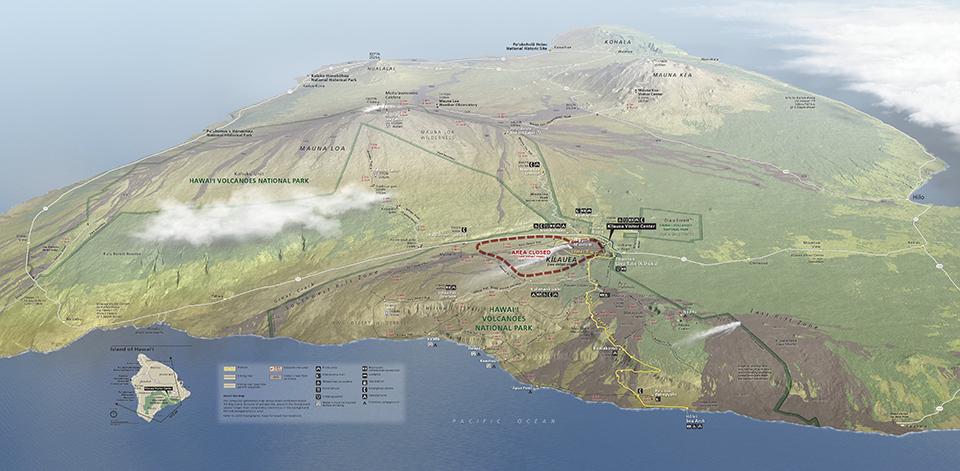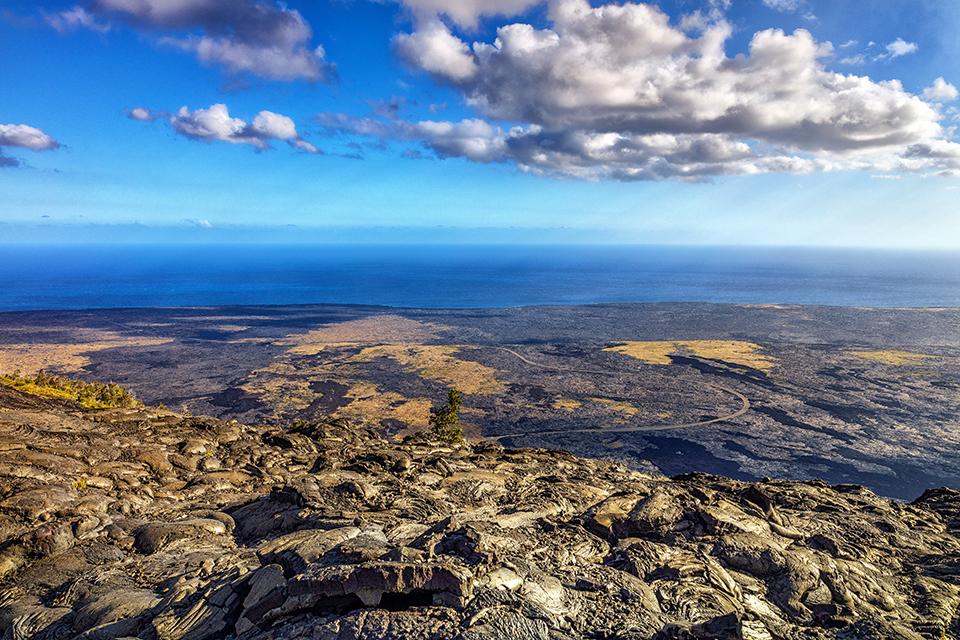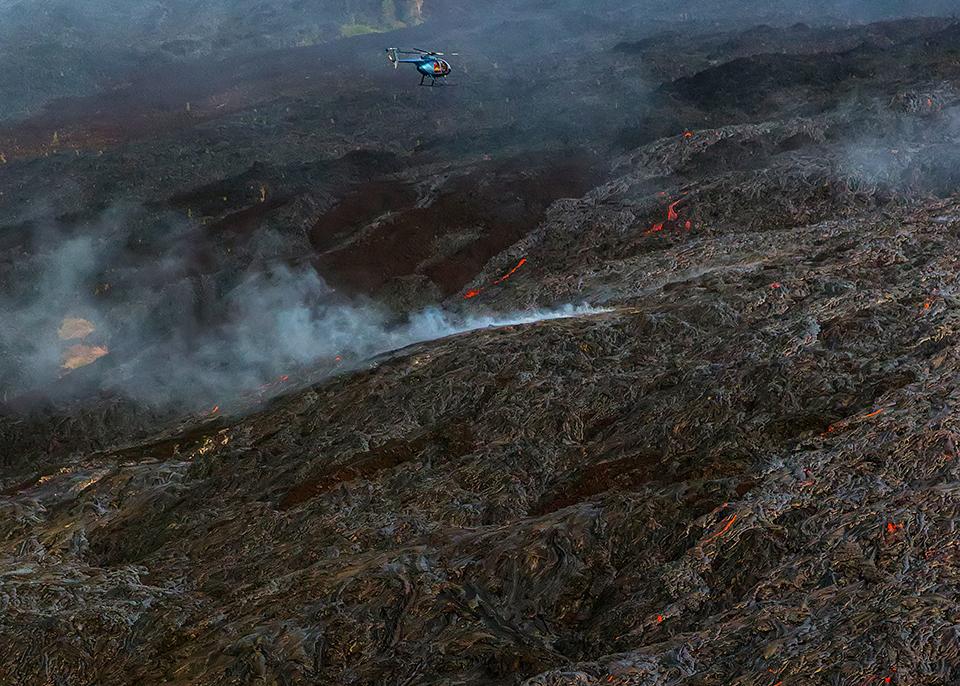
A late-afternoon view over Kilauea Volcano, Hawai'i Volcanoes National Park / Rebecca Latson
Ahhh, paradise. What better place to relax and unwind than in Hawaii, right? However, if you decide you’d like a little more excitement and want to venture away from your swinging hammock or beach towel on the sand, how about a visit to Hawai’i Volcanoes National Park, where you can hike through a rain forest and over a solidified lava lake, drive past golden pahoehoe lava flows, and view up-close the home of the goddess Pele. This Traveler’s Checklist will help you plan for your visit to make the most of your time in the park.

Map of Hawai'i Volcanoes National Park / National Park Service
- Hawai’i Volcanoes National Park is located on the Big Island of Hawaii. There are two airports on the Big Island that accommodate major air travel: Kona International and Hilo International airports. It’s about a 40-minute drive south to the park from the Hilo airport, and at least a 2-hour drive south and then northeast from the Kona airport. Reserve your rental vehicle far ahead of your visit. If you plan to spend your entire visit in the national park, Hilo or historic Volcanic on the park's doorstep make far better base camps than Kona.
- There are a number of lodging choices. At the one in-park lodge: Volcano House, you can reserve a room or cabin, or a spot at the Namakanipaio Campground from this lodge. I stayed in one of the hotel’s Volcano Crater Rooms for a view of Halema’uma’u crater. My room was small but clean with a plush bed and I could view the distant crater – especially dramatic at night - from the screened window. At historic Volcano, the Kīlauea Lodge and Restaurant is another option that's just a mile from the park. It's a decidedly quieter setting, too, as there are only a dozen rooms and cottages, with each offering its own unique room setting. There are a number of accommodations in Hilo as well as the smaller Volcano, Hawaii, a 5-minute drive from the park. Don’t forget to check Airbnb and Vrbo for lodging options.
- The dining room in Volcano House is excellent, so make a note to enjoy a meal there regardless of where you are staying for the night. Not only were my meals there scrumptious, but beautifully plated. You can also have a meal and a little libation at Uncle George’s Lounge inside Volcano House, next to the dining room. Volcano has a few small restaurants worth checking out.
- While April through June and September through November are considered good times to visit the park weatherwise, I visited in both February and October and encountered mostly good weather with a few rainy, windy days mixed in. Be prepared for Texas-like heat and humidity upon landing at Hilo. The weather is drier on the Kona (west) side of the island. You’ll leave that Hilo humidity behind as you head toward the park and its 4,000-foot elevation gain, so remember to pack a jacket and some raingear for yourself and your camera.

A view of the ocean beyond the lava flows along the Chain of Craters Road, Hawai'i Volcanoes National Park / Rebecca Latson
- Drive the 18.8-mile Chain of Craters Road to view old lava flows (some of which really do shine like gold in the sunlight), craters, expansive landscape views, petroglyphs, and a sea arch near the end of the road.
- Stargaze. Find a safe spot where you can view the red-orange glow of Halema’uma’u crater from within Kilauea caldera while viewing the sparkling stars and Milky Way above. For tips on night photography, click here.
- Go hiking. Feel the warm breath of steam issuing from a vent alongside the trail, hold your nose as you tour the pungent sulphur banks, walk through the Thurston (Nāhuku) Lava Tube, or hike over lava fields or through lush rain forests. There are a number of trails within the park that offer glimpses of the environments encompassed by the park. If you only have time for one hike, then make it the Kilauea Iki trail, a loop that takes you down through a tropical rain forest and onto a “frozen” lava lake. If you feel like stretching your legs on a much longer trail, then get a permit for backcountry camping and choose from one of several backcountry destinations.
- For a longer backcountry trek, make reservations for the two cabins along the Mauna Loa Trail on the north side of Highway 11. This is a 19-mile trek, one way, from the Mauna Loa Road that gains roughly 9,200 feet on the way to the Mona Loa Cabin. Add another 427 feet of elevation to reach the volcano's summit.
- Check out the "Tree Molds" near the bottom of the Mauna Load Road. These formed when molten lava wrapped around the trunks of trees. While the tree ultimately dies, the form of its trunk is captured in the hardened lava.
- During your hikes, be on the lookout for small shrubs with bright yellow and red-spotted Ōhelo berries. These sweet-tart berries are tasty parts of the threatened nēnē’s (Hawaiian goose and state bird) diet, so just pick a few and remember to give that first berry you pick to the goddess Pele as a courtesy.
- Speaking of Nēnē, “this bird is a threatened species that needs your protection. Watch for Nēnē on roads. Cars are the leading cause of adult Nēnē deaths in the park. DO NOT FEED the Nēnē. Nēnē that are fed by visitors learn to beg for food and approach moving cars. Be aware that you’ll share the park roads with the NēNē, so drive the posted speed limit and be on the watch for these beautiful birds.”
- Explore the Steam Vents on the rim of Halema’uma’u Crater. Cross Highway 11 from the Steam Vents parking area to walk the trail to the Sulphur Banks.
- Go for a bicycle ride. The roads are narrow, so ride single file and remember to follow the rules of the road. Take plenty of water and food, and be aware that traffic is heaviest between 10 a.m. and 3 p.m. Be aware that it might be more than a little windy on the road, too, so be prepared for an extra workout.
- If you plan on some photography, make sure your tripod is sturdy, because the wind blows fiercely in the park and over the lava fields. From personal experience, I can tell you my lighter-weight tripod fell over in the wind, completely breaking in half a camera lens and cracking my digital camera’s rear LCD screen. Lesson learned. The next time I visit the park, I’ll being my heavy-duty tripod.
- Reserve a spot in a helicopter for a thrilling ride over active volcanism in the park. The views are incredible as is the sense of adventure. A Google search will show you several helicopter tour operations in Hilo.
- Check at the visitor center to see what ranger programs and other special events are available. During my October visit, I watched a hula demonstration at the park’s Kahua Hula (dance platform).
- If you are in a shopping mood, visit the Volcano Art Center near the park’s visitor center for a one-of-a-kind gift and original work of art.
- Take a side trip out of the park and up to Mauna Kea, where you can reserve a seat on one of a number of shuttle tours to the 14,000-foot summit to view the sunset. It’s a heady experience.
- Take another side trip to a coffee plantation near the park. I visited K’au Coffee Mill, 15 miles outside of the park, and fell in love with their washed medium road coffee.
- Consider taking one more side trip a little over 18 miles further south of the park to view and photograph endangered hawksbill and green sea turtles basking upon the black sands of Punalu’u Beach.
- Above all, during your visit to this national park, be respectful of the park landscape as well as the people who live around and visit the park. Take the Pono Pledge “to be safe, responsible and respectful to each other and the ʻāina (land) during your visit to Hawaiʻi.”
- Before you go on your trip, remember to check the park’s website to find out if and where pets are allowed and whether or not there are any closures or restrictions due to construction, weather, volcano eruptions, or Covid-19.
- As you make your trip plans, remember, the coronavirus pandemic is not over, yet. Per the National Park Service, whose parent organization is the Department of the Interior: “To protect the health of those who live, work, and visit America’s national parks, face masks are required in all NPS buildings and facilities. Masks are also required on NPS-managed lands when physical distancing cannot be maintained, including narrow or busy trails, overlooks, and historic homes.” So, travel safely, take some masks, practice social distancing and wash your hands often.

Hovering over the lava flows, Hawai'i Volcanoes National Park / Rebecca Latson



Add comment